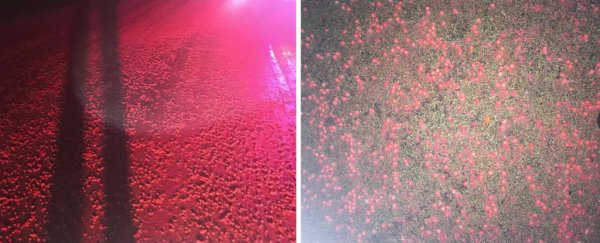Late last week, hundreds of thousands of Skittles were found covering the Dodge County Highway in Wisconsin, having fallen off the back of a truck overnight.
But the fact that someone had a leaky truck filled exclusively with red Skittles isn't the strangest part of the story - local police report that they were on their way to local farms to be used as cattle feed. Why? Because it's cheap alternative to corn.
"The Skittles were confirmed to have fallen off the back of a truck," Dodge County Sheriff Dale Schmidt reported on Facebook last week.
"It is reported that the Skittles were intended to be feed for cattle as they did not make the cut for packaging at the company. In the end, these Skittles are actually for the birds!"
If all of this is making you a little uncomfortable, we don't blame you - this is some out-there stuff, and it's not the most reassuring thing to know that beef cattle are being fed Skittles in bulk.
Not only that, but it's been weirdly difficult for investigators to tease out exactly what's been going on here.
Local reporters affiliated with CNN were the first to bring the public's attention to what happened, but it took some time for officials to actually confirm what those sticky red candies on the road were.
"There's no little 'S' on them, but you can definitely smell, it's a distinct Skittles smell," Sheriff Schmidt told CNN affiliate WISN.
#News @949WOLX: Have you seen this? #Skittles dropped by truck along Hwy S in #DodgeCounty (oops). Still there this AM; helping on icy roads pic.twitter.com/G4lF1WhpZ9
— Teri Barr (@TeriBarrMedia) January 19, 2017
But when reporters contacted Skittles producer, Mars, it insisted that while some of their unwanted products are used for animal feed, the Skittles in question did not come from a factory that engages in that practice.
"We don't know how it ended up as it did and we are investigating," Mars said at the time.
Meanwhile, Sheriff Schmidt told the media he'd been in contact with a local farmer, who had explained the practice of using discarded Skittles as cattle feed, but the farmer's identity - and information on whether or not his farm uses Skittles - has been withheld.
A Mars spokesperson then came out and confirmed that the red sludge on the road really was a bunch of Skittles that didn't make the grade for human consumption - hence the lack of "S" the Sheriff observed.
As Candice Choi reports for the Associated Press:
"Linda Kurtz, a corporate environmental manager at Mars, said the company sells unused candies and ingredients to processors that incorporate them with other materials to make animal feed. She said Mars does not sell directly to farmers, and its procedures follow Food and Drug Administration regulations.
Kurtz said Mars determined the spilled Skittles came from its plant in Yorkville, Illinois, which does not sell products for animal feed. The other US plant that makes Skittles, in Waco, Texas, sells to a local processor that melts them down into syrup."
Some details are still frustratingly vague here, but the fact that farmers are feeding Skittles to their cows is pretty clear. So what does that mean for consumers?
As Doug Criss reports for CNN, "A former farmer told CNN affiliate WBAY that candy makers and bakeries often sell rejects to be used as cattle feed because they provide 'cheap carbs'.
Apparently, the practice goes back decades, but really took off in 2012, when corn prices were surging and local formers were looking for cheaper alternatives.
Turns out, discarded candy isn't only cheaper than corn during times of drought - farmers claim it's just as nutritious.
"(It) is a very good way for producers to reduce feed cost, and to provide less expensive food for consumers," Ki Fanning, a livestock nutritionist with Great Plains Livestock Consulting, told CNNMoney at the time.
But it's all well and good to try and reduce costs for consumers, but is all that sugar-loading even safe?
Eli MacKinnon from Live Science spoke to a scientist back in 2012 about the practice, and he was surprisingly chill about the whole thing, and basically told everyone there's nothing to worry about.
"I think it's a viable [diet]. It keeps fat material from going out in the landfill, and it's a good way to get nutrients in these cattle. The alternative would be to put [the candy] in a landfill somewhere," John Waller, a professor of animal nutrition at the University of Tennessee, told MacKinnon.
"Ruminant animals are very good at utilising a wide variety of feedstuffs, because the microbes in the rumen can digest things that other animals can't utilise."
Robin Shreeves from Mother Nature Network also found that the US Animal Legal Defense Fund has a list of scraps from food production that can go into cattle feed, including cookies, breakfast cereal, orange peels, dried fruit, taco shells, refried beans, cottonseed hulls, rice products, potato products, and peanut pellets.
While the industry seems pretty content with its candy-feeding ways, the consequences for the environment are not yet clear.
A 2012 study published in the Journal of Dairy Science found that high-sugar grasses could increase methane emissions, which means high-sugar feed could be having similar effects.
